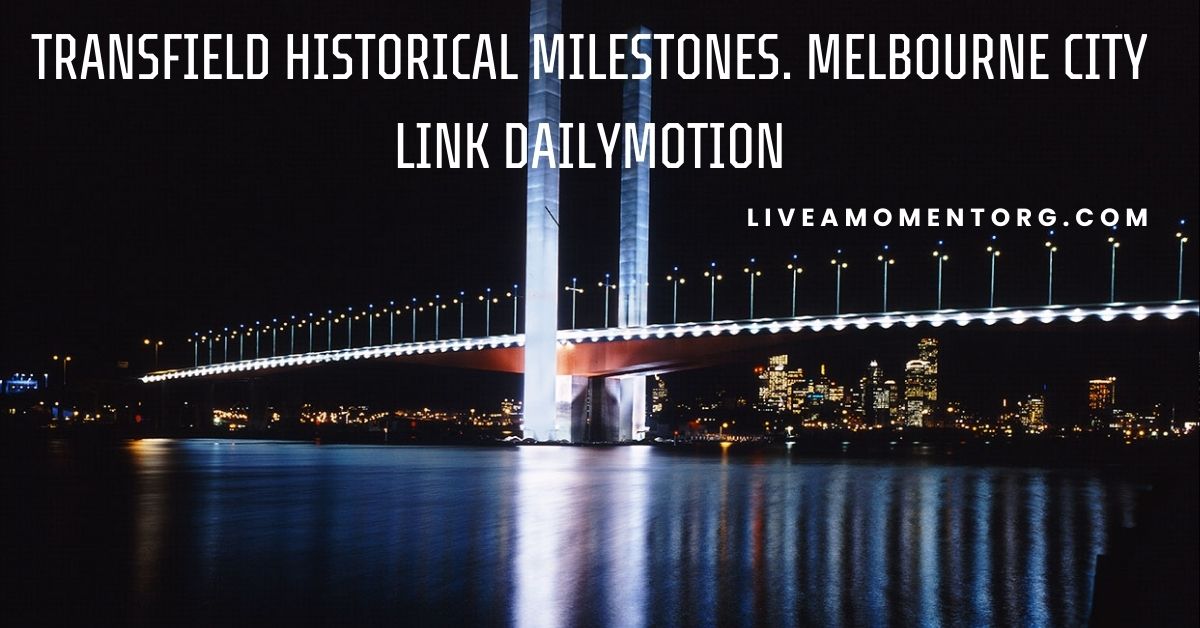Transfield Historical Milestones. Melbourne City Link Dailymotion
The Melbourne CityLink project stands as one of the most significant infrastructure developments in Australia’s history. At the heart of this massive undertaking was Transfield, an engineering and construction powerhouse that played a pivotal role in shaping Melbourne’s transportation landscape. This article will explore the key historical milestones of Transfield’s involvement in the Melbourne CityLink project, with a special focus on how this transformative initiative has been documented and shared through platforms like Dailymotion.
The Birth of a Vision: Transfield and Melbourne CityLink
In the early 1990s, Melbourne faced growing traffic congestion and a pressing need for improved urban connectivity. The concept of CityLink emerged as a bold solution – a network of tolled motorways that would link key areas of the city and dramatically reduce travel times. Transfield, with its proven track record in large-scale infrastructure projects, was well-positioned to take on this monumental challenge.
- Project Inception and Planning (1992-1995)
The seeds of the Melbourne CityLink project were planted in the early 1990s. During this crucial planning phase, Transfield worked closely with government officials, urban planners, and community stakeholders to develop a comprehensive vision for the project. Key milestones during this period included:
- Feasibility studies and traffic modeling to determine optimal routes
- Environmental impact assessments to address potential concerns
- Community consultations to gather input and build public support
- Preliminary design work to establish the project’s scope and scale
- Contract Award and Consortium Formation (1995)
In a watershed moment for both Transfield and Melbourne’s infrastructure development, the company was awarded the contract to design, construct, and operate CityLink in 1995. This milestone marked the beginning of a new era in public-private partnerships in Australia. Key aspects of this milestone included:
- Formation of the Transurban CityLink consortium, with Transfield as a major partner
- Negotiation of a 34-year concession agreement with the Victorian government
- Securing of financing for the $1.8 billion project, a landmark deal at the time
- Construction Commencement (1996)
With contracts signed and funding secured, Transfield broke ground on the CityLink project in 1996. This marked the start of one of the most ambitious urban infrastructure projects in Australian history. Notable elements of this phase included:
- Mobilization of a massive workforce, creating thousands of jobs
- Implementation of cutting-edge construction techniques and technologies
- Careful coordination with existing transportation networks to minimize disruption
- Engineering Innovations and Challenges (1996-2000)
Throughout the construction phase, Transfield encountered and overcame numerous engineering challenges. These obstacles became opportunities for innovation, pushing the boundaries of infrastructure development. Key milestones in this area included:
- Design and construction of the Bolte Bridge, a 490-meter cable-stayed bridge spanning the Yarra River
- Development of the Burnley and Domain Tunnels, utilizing advanced tunnel boring techniques
- Implementation of state-of-the-art electronic tolling systems, a first for Australia
- Staged Openings and Public Reception (1999-2000)
As sections of CityLink neared completion, Transfield oversaw a series of staged openings. These milestones allowed the public to gradually experience the benefits of the project while providing opportunities for fine-tuning operations. Significant openings included:
- Western Link (Tullamarine Freeway to West Gate Freeway) in August 1999
- Southern Link (including the Monash Freeway) in December 1999
- Burnley Tunnel in December 2000, marking the full completion of CityLink
- Project Completion and Handover (2000)
The official completion of the Melbourne CityLink project in 2000 marked a monumental achievement for Transfield. This milestone represented the culmination of years of planning, engineering, and construction expertise. Key aspects of the completion included:
- Formal handover of operations to Transurban
- Implementation of full electronic tolling across the network
- Celebration of reduced travel times and improved connectivity for Melbourne commuters
Documenting History: CityLink on Dailymotion
As the digital age progressed, platforms like Dailymotion became valuable repositories for documenting and sharing the story of Melbourne CityLink. This video-sharing website has played a role in preserving the historical milestones of the project through various types of content:
- Construction Time-Lapses
Dailymotion hosts several time-lapse videos showcasing the construction of key CityLink elements. These captivating visual records compress years of work into minutes, allowing viewers to appreciate the scale and complexity of the project.
- Historical Documentaries
Documentaries detailing the planning, construction, and impact of CityLink can be found on Dailymotion. These in-depth explorations often feature interviews with Transfield engineers and executives, providing unique insights into the project’s challenges and triumphs.
- News Archives
Archived news reports from the CityLink construction era are available on Dailymotion, offering a window into the public perception and media coverage of the project as it unfolded.
- Educational Content
Engineering and urban planning students can access educational videos on Dailymotion that use CityLink as a case study in successful infrastructure development.
- Anniversary Retrospectives
As CityLink celebrates milestones, retrospective videos are shared on Dailymotion, chronicling the project’s lasting impact on Melbourne’s urban landscape.
The Legacy of Transfield and Melbourne CityLink
The completion of Melbourne CityLink stands as a testament to Transfield’s engineering prowess and vision. The project’s success has had far-reaching implications:
- Economic Impact
CityLink has significantly reduced travel times, boosting productivity and economic growth in Melbourne. The project’s success has attracted businesses to areas with improved accessibility, reshaping the city’s commercial landscape.
- Urban Development
The improved connectivity provided by CityLink has influenced Melbourne’s urban development patterns, encouraging growth in previously underutilized areas and contributing to the city’s expansion.
- Environmental Considerations
While initially controversial, CityLink’s impact on traffic flow has had some positive environmental effects, reducing idling times and overall emissions from congested traffic.
- Technological Advancements
The electronic tolling system pioneered by CityLink has become a model for similar projects worldwide, showcasing Australian innovation in transportation infrastructure.
- Public-Private Partnership Model
The success of the CityLink project as a public-private partnership has influenced infrastructure development strategies across Australia and internationally.
Looking to the Future: CityLink’s Ongoing Evolution
As Melbourne continues to grow and evolve, so too does the CityLink network. Ongoing developments and future plans include:
- Capacity Enhancements
Plans are underway to increase the capacity of key CityLink sections to accommodate Melbourne’s growing population and traffic demands.
- Integration with New Projects
CityLink is being integrated with newer infrastructure projects, such as the West Gate Tunnel, to create an even more comprehensive transportation network.
- Technological Upgrades
Continuous improvements to tolling systems, traffic management technologies, and user interfaces are being implemented to enhance the CityLink experience.
- Sustainability Initiatives
Efforts are being made to reduce the environmental impact of CityLink through the use of more sustainable materials and energy-efficient technologies.
Conclusion : Transfield Historical Milestones. Melbourne City Link Dailymotion
The historical milestones of Transfield’s involvement in the Melbourne CityLink project represent a pivotal chapter in Australia’s infrastructure development. From its inception to its ongoing evolution, CityLink has transformed Melbourne’s urban landscape and set new standards for large-scale transportation projects. The preservation of this history through platforms like Dailymotion ensures that future generations can appreciate the vision, challenges, and achievements that shaped this remarkable endeavor.
As we look to the future, the legacy of Transfield and Melbourne CityLink continues to influence infrastructure projects around the world. The lessons learned, innovations developed, and partnerships forged during this monumental undertaking will undoubtedly shape the cities of tomorrow.
FAQs about the Transfield Historical Milestones. Melbourne City Link Dailymotion
What is Melbourne CityLink?
Melbourne CityLink is a network of tolled urban freeways in Melbourne, Australia, connecting major highways and providing crucial links between the city’s airport, central business district, and suburbs.
When was Melbourne CityLink completed?
The Melbourne CityLink project was fully completed in December 2000, with various sections opening in stages between 1999 and 2000.
What role did Transfield play in the CityLink project?
Transfield was a major partner in the consortium that designed, constructed, and initially operated CityLink. They were responsible for much of the engineering and construction work on the project.
How long did it take to build CityLink?
The main construction phase of CityLink lasted approximately four years, from 1996 to 2000.
What are some key features of Melbourne CityLink?
Key features include the Bolte Bridge, Burnley and Domain Tunnels, and an electronic tolling system that was groundbreaking for its time.
How has CityLink impacted travel times in Melbourne?
CityLink has significantly reduced travel times for many commuters, with some journeys being cut by up to 30 minutes during peak hours.
What is the length of the CityLink network?
The entire CityLink network spans approximately 22 kilometers (14 miles).
How is CityLink funded?
CityLink operates under a public-private partnership model, with tolls collected from users funding the ongoing operation and maintenance of the network.
Can I find videos about CityLink’s construction on Dailymotion?
Yes, Dailymotion hosts various videos documenting CityLink’s construction, including time-lapses, documentaries, and news reports from the era.
How has CityLink influenced other infrastructure projects?
The success of CityLink has served as a model for other large-scale infrastructure projects in Australia and internationally, particularly in terms of public-private partnerships and electronic tolling systems.







